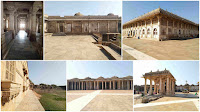Junagadh literally means Old (Juna) Fort (Gadh). A different
etymology derives the name from "Yonagadh" (literally, "City of
the Yona (Greeks)", referring to the ancient inhabitants of the city under
the Indo-Greek Kingdom). It is also known as "Sorath", the name of
the princely state of Junagadh.
The city of Junagadh has an imprints of two and a half millennia
of human civilization, so inevitably it has been ruled by a multiple rulers. Maurya Dynasty ruled over Junagadh in 319 BC. Kalinga,
Greeks, Gupta, Mughals are few other dynasties to rule this city. During his
rule, Sultan Mahmud Begada changed the name of Junagadh to Mustafabad and built
the fortifications around the town and the mosque in Uparkot Fort. The fight
for Junagadh’s crown continued even after the British India's rule. After a brief
struggle between India and Pakistan, Junagadh decided to join India in 1947. A part of
Saurashtra state then, later became a part of Bombay state and finally became
integral part of Gujarat state in 1960.
Towering over the city is Mt. Girnar, a holy site for Hindus and
Jains and the highest peak in Gujarat. Girnar Hill is an extinct volcano, which
has been a holy place for Buddhist, Jains and Hindus since the 3rd century BC.
The ancient Guru
Dattatreya Temple is at the hilltop and one has to climb 9,999 steps to reach there. Guru
Dattatreya is considered to be the human manifestation of the Hindu trinity of
Gods, Bramha Vishnu & Maheshwara. In Hinduism it is customary to do a circumambulation ('Pradakshina'
or 'Parikrama') around deities and temple. Girnar Parikrama is said to bear fruits as you do a
Pradakshina to all the saints, sadhus, Gods and Goddesses who reside in the
Girnar mountain range. This Girnar Parikrama, 36 km in length, is only open for
5 days in a year before Kartiki pournima (~ Nov/Dec). The Girnar Parikrama is
done only through the dense Girnar Jungles, which otherwise are not accessible due to restrictions from the forest department.
Being the capital of Junagadh princely state once, the town
shines with historical significance with many historical monuments. Amongst
the numerous attractions, places like Girnar, Mahabat Maqbara,
Uperkot fort, Sakkarbaug Zoological Garden, Damodar Kund and Damodarji Temple, Buddhist Caves and Ashoka's Rock Edicts are some of the favorite of the tourists. Jungadh's main attraction, however, remains
the Girnar hill, located towards the east of the city. The city has several
lakes: Narsinh Mehta Sarovar, Damodarji, Sudarshan Lake, etc. and few dams: Willingdon
Dam, Hasnapur Dam, and Anandpur Weir.
My Verdict:
Junagadh is a true amalgamation of Hinduism, Jainism, Buddhism,
and Islam and has a unique significance in history. One can see inscriptions,
edicts, caves, temples, forts, stepwells, tanks and canons dating back to 2nd
century AD, and not to forget the Girnar Hill. So history, architecture,
religion, street shopping or physical fitness, whatever is your reason, Junagadh
is the answer for you.
Best time to visit:
Around the year for Junagadh, Nov/Dec for Parikrama (as per
Hindu calendar)
Places around:
Sasan Gir (National park for lions), Somnath, Diu
Tips:
- Don’t worry, if you have forgotten to carry something for your Junagadh trip, you will get almost everything here.
- A number of accommodation options are available here - Dharamshala, Aashram, Home stays, Hotels, Resort, etc.
- Getting an auto is easy and it costs you around 100-150 Rs. for short travels in the city. The autos are bigger and can easily accommodate ~6 people. Taxis are also available on hire for sightseeing and visiting the city attractions.
- Junagadh is well connected, by Road, Train and Bus, to all the big cities in Gujarat.
This place on map:
Tags:
Weekend Trip, Monsoon Drive, Heritage, Ahmedabad Getaways,
History, Religious






